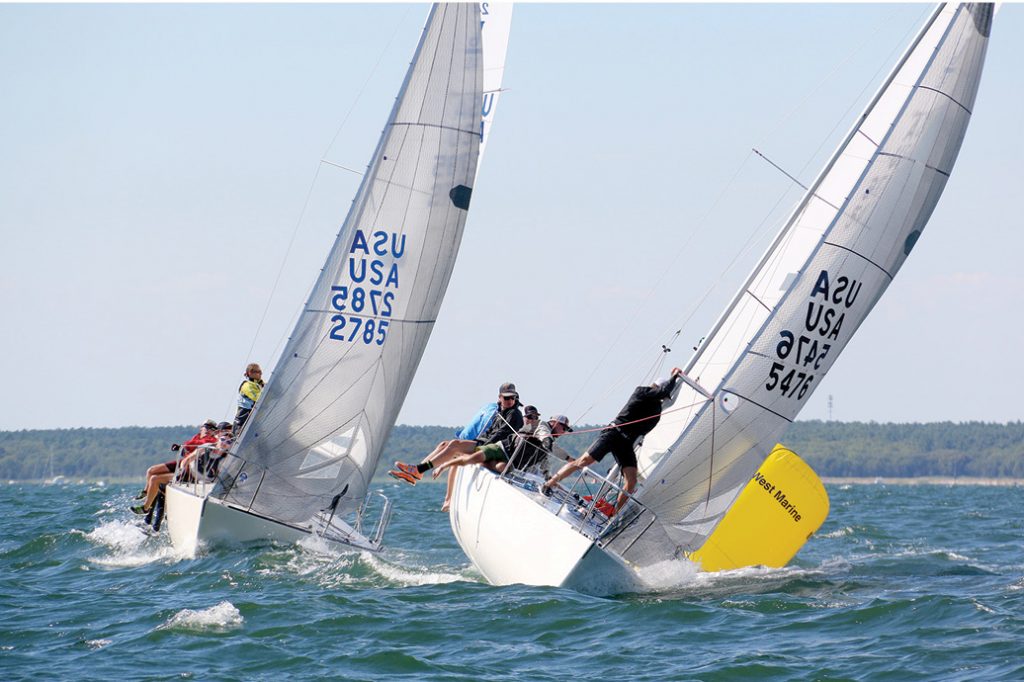By David Dellenbaugh
Unless you need to slow down for tactical maneuvering, one of the most important things at any mark rounding is maintaining speed while you turn. Steering a curved course means you have to angle the rudder off centerline. This creates drag and slows the boat. So in most cases, turn the boat as little as possible. When you do have to make big turns, like when rounding marks, you need good technique to keep going as fast as possible. This requires an optimal combination of rudder movement, weight placement and sail trim.

When you approach the first mark, it’s easy to get distracted by everything that’s happening. There are usually lots of boats around, for example, and it often seems like half your crew is getting the chute ready. However, when you are distracted, most likely you aren’t sailing your boat too quickly. Therefore, as you get closer to the mark, it’s very important to stay focused on maintaining speed, especially for the
Turn the rudder as a last resort
It’s nice to think you could make all your turns on the racecourse without using the rudder at all, but this is probably not possible. In practice, most sailors use the rudder quite a bit, especially during big turns like mark roundings, and especially when they have to maneuver in tight quarters around other boats.
But you should still try to use your rudder as little as possible. Work with weight and sail trim first, and move the rudder just enough to match the turn created by these other methods. When you must use your rudder, be gentle. Don’t turn it too quickly or too far, and use a constant rudder angle for speed.
Move crew weight for turns
One way to help turn your boat with less rudder drag is by using crew weight to change your angle of heel. If you want the boat to turn to port, heel to starboard. If you want it to turn to starboard, heel to port. When you are turning around a mark, heel the boat to the outside of the turn. For example, if you want to bear off around the windward mark, heel the boat to windward (to starboard for a port rounding). Even if you don’t have enough weight to heel the boat to windward, try to reduce leeward heel as much as possible.
At the windward mark, a common mistake is for crews to move in off the windward rail too soon. This allows the boat to heel and makes it harder to bear off. Keep hiking fully until you have borne away; then you can move in to set the chute.
Moving weight is most effective (and important) in light air when there is not so much pressure in the sails (and therefore changes in sail trim have less effect on turning).
Adjust sail trim for turning
Adjustments in sail trim are usually effective for turning a boat quickly and efficiently. If you’ve ever been on a sailboard, for example, you know how to move your rig forward to bear off and aft to head up.
A sailboat is similar. If you want to head up, ease your jib and trim your main. An undertrimmed jib allows the bow to turn toward the wind more easily, while an overtrimmed main pushes the stern to leeward. Do the opposite to bear off: trim the jib and ease the main.
Adjusting your sail trim to turn your boat helps in every condition, but it’s especially critical when the wind is strong. If you’ve ever tried bearing off around the first mark on a windy day without easing your mainsheet, you know how critical it is to use your sails for steering. ■
This article originally appeared in David Dellenbaugh’s Speed & Smarts, The newsletter of how-to tips for racing sailors. If you want to sail faster and smarter, log onto SpeedandSmarts.com.
A resident of Easton, CT, Dellenbaugh was tactician and starting helmsman for America3’s successful defense of the America’s Cup in 1992. He’s a Lightning World Champion, two-time Congressional Cup winner, seven-time Thistle National Champion, two-time winner of the Canada’s Cup, three-time Prince of Wales U.S. Match Racing Champion, and a winner of the U.S. Team Racing Championships for the Hinman Trophy.




